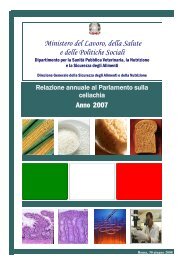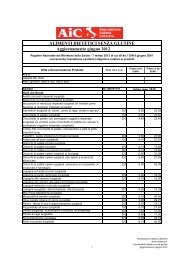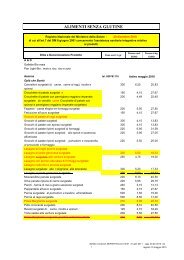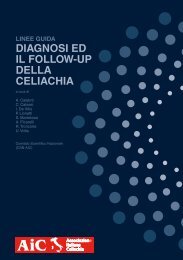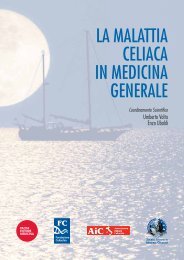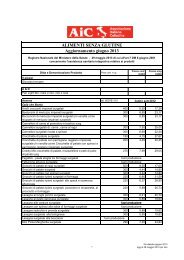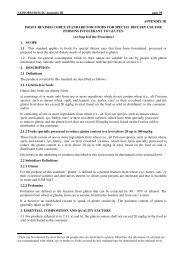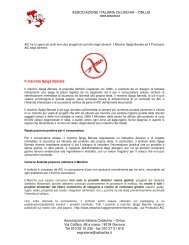primary prevention of coeliac disease - Associazione Italiana ...
primary prevention of coeliac disease - Associazione Italiana ...
primary prevention of coeliac disease - Associazione Italiana ...
Create successful ePaper yourself
Turn your PDF publications into a flip-book with our unique Google optimized e-Paper software.
34<br />
COELIAC DISEASE IN THE SAHARAWI<br />
DQB1 genes and dot blot analysis <strong>of</strong> amplified DNA with sequence specific<br />
19-21<br />
oligonucleotide probes (SSO) were carried out as previously reported . The DQA1<br />
alleles were inferred using the known patterns <strong>of</strong> linkage disequilibrium from the<br />
DRB1-DQB1 haplotypes.<br />
Parental haplotypes were reconstructed using a program written by Frank<br />
Dudbridge available at ftp://ftp-gene.cimr.cam.ac.uk/pub/s<strong>of</strong>tware/.<br />
A possible drawback <strong>of</strong> case-control analyses is their sensitivity to problems related<br />
to genetic stratification. In order to circumvent this problem, 82 affected family-based<br />
control, (AFBAC) DQA1-DQB1 haplotypes have been selected from all the families in<br />
22<br />
which the parents were available, as described for single alleles by Thomson . The<br />
AFBAC frequencies are based on the chromosomes that are never transmitted from the<br />
parents to affected children and provide a source <strong>of</strong> controls which is not sensitive to<br />
population stratification unless very recent. The control frequencies were also enriched<br />
by 18 chromosomes deriving from 9 unaffected and unrelated Saharawi individuals.<br />
The pseudo-controls (AFBAC) and control frequencies were nearly identical and<br />
therefore were merged (total controls equal to 100 chromosomes). Using these control<br />
haplotype frequencies and assuming Hardy-Weinberg equilibrium, we also established<br />
23<br />
the control genotype frequencies as previously described . The frequencies <strong>of</strong> the HLA<br />
class II haplotypes and genotypes obtained in patients and in controls, were then<br />
compared using a 2 x 2 chi-squared Pearson test. The odds ratios ORs) were calculated<br />
using the Wolf formula [a x d)/(b x c)]; when one element <strong>of</strong> this equation was 0 we used<br />
the Haldane formula: RR=[2a + 1) 2d +1)]/[2b +1) 2c +1)], where a is the number <strong>of</strong><br />
patients possessing the HLA antigen; d is the number <strong>of</strong> controls lacking the particular<br />
HLA antigen; b the number <strong>of</strong> patients lacking the particular antigen; c the number <strong>of</strong><br />
controls possessing the particular HLA antigen. In the association analyses performed<br />
in this study, we considered only the probands in the 8 families with more than one<br />
affected sibling. A correction for number <strong>of</strong> tests performed was applied by multiplying<br />
the P values for the tested markers present in more than 1 patient or 1 control<br />
(respectively 10 haplotypes and 8 genotypes).<br />
We also evaluated the evolutionary relationship between the Saharawis and the<br />
24<br />
other human groups. To this aim we performed a multi-dimensional scaling analysis<br />
carried out using the correlation matrix <strong>of</strong> the haplotype frequencies reported in the<br />
various populations and determined with a gene counting procedure.<br />
Who are the Saharawis?<br />
In order to obtain a visual output <strong>of</strong> the DRB1-DQA1-DQB1 haplotype distribution<br />
worldwide and obtain information about the evolutionary relationships between the<br />
various human groups we performed a multi-dimensional scaling analysis. The results<br />
<strong>of</strong> this analysis are shown in Fig.1. The first dimension splits Eastern and Western world<br />
populations. The Asian and the African appear to be the most differentiated human<br />
groups, with the Kogi and Cayapa native American populations as the most<br />
differentiated within the Asian group. The Caucasians are closely grouped and are<br />
located between the African and the Asian range <strong>of</strong> variability. The second dimension<br />
explains the diversity <strong>of</strong> the Caucasian group, which includes the North-African and the<br />
Saharawi samples. More specifically, the Saharawi population appears to be located in





